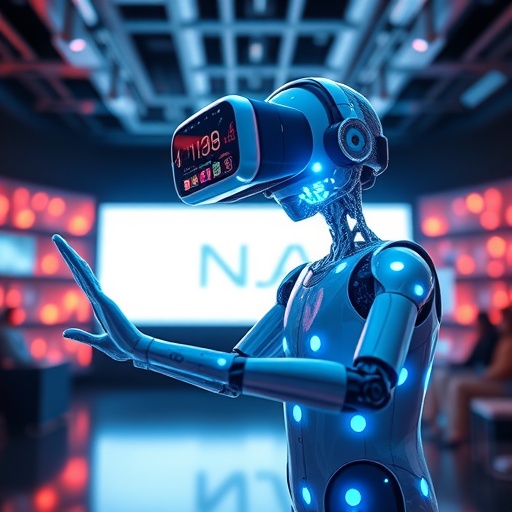In the rapidly evolving landscape of educational technology, a groundbreaking development is poised to redefine higher education pedagogy. Researchers Hemminki-Reijonen, Hassan, Huotilainen, and their collaborators have introduced an innovative design framework that integrates generative artificial intelligence (AI) with virtual reality (VR) environments to transform university-level teaching and learning processes. This cutting-edge study, published in npj Science of Learning, explores how generative AI models can dynamically adapt educational content and interactions within immersive VR spaces, thereby offering tailored, intuitive, and highly interactive learning experiences.
At the core of this advancement is the seamless fusion of generative AI with 3D virtual realities, creating pedagogical environments that transcend traditional classroom limitations. Unlike static VR modules, generative AI-powered pedagogy develops learning scenarios on-the-fly, responding intelligently to individual students’ needs, cognitive profiles, and progress. This design marks a significant departure from conventional simulations or linear VR content, enabling educational contexts that are not only immersive but also continuously customized. Such fidelity to personalized learning paves the way for greater engagement and improved knowledge retention.
The research team highlights the unique capabilities of generative AI models—such as those employing deep learning architectures and reinforcement learning algorithms—in generating adaptive dialogue, problem-solving tasks, and contextual feedback within VR settings. These AI agents serve as virtual tutors, peers, or learning facilitators who can interpret student responses, scaffold understanding, and guide cognitive development through tailored interactions. This approach effectively bridges the gap between human educator intuition and automated learning analytics, leveraging AI’s capacity to process vast learner data in real time.
One technical hallmark of the study involves the architecture underpinning the integration of AI and VR. The model relies on a multi-layered system: the sensory input layer captures student movements, gaze, and verbal utterances within the VR environment; the cognitive processing layer employs generative AI to analyze and predict learner needs; the content generation layer then recreates or morphs educational scenarios accordingly. This pipeline ensures uninterrupted, context-aware adaptation that preserves immersion while advancing pedagogy.
Furthermore, the project confronts common challenges associated with both VR and AI learning technologies. For instance, VR-induced cognitive overload and potential motion sickness are mitigated by the AI’s ability to regulate complexity, pacing, and informational density based on biometric and behavioral cues. Meanwhile, the inherent unpredictability of generative AI content is managed through rigorous constraints and ethical filters embedded within the pedagogical engine, ensuring educational relevance and appropriateness.
Another pivotal aspect of their work is the system’s focus on higher-order cognitive skill development, crucial in tertiary education. The VR environments designed stimulate critical thinking, creativity, and collaborative problem-solving through AI-facilitated scenarios that evolve based on learner input. Students engage with complex, open-ended problems in simulated yet authentic contexts, yielding learning outcomes that extend beyond rote memorization to application and synthesis of knowledge.
The implications for accessibility and inclusion are profound. Generative AI within VR can dynamically tailor content to accommodate diverse learning styles, language proficiencies, and even physical disabilities, effectively democratizing quality education. For example, AI agents can simplify explanations, provide multilingual support, or adapt interaction modalities for those with limited motor skills, thus fostering an equitable learning arena.
Additionally, the paper discusses integration with institutional digital ecosystems, highlighting interoperability with learning management systems (LMS) and educational data warehouses. This integration facilitates continuous assessment and real-time analytics, empowering educators and administrators to monitor student progress and make data-driven decisions. The generative AI doesn’t merely personalize content in isolation but functions as part of a broader educational infrastructure aimed at optimizing learning trajectories.
From a technical standpoint, the researchers utilized state-of-the-art generative transformer models, fine-tuned on domain-specific educational corpora, to ensure relevance and accuracy. These models, embedded within the VR frameworks powered by advanced graphics engines, enable naturalistic dialogue generation, contextual scenario crafting, and complex environment manipulations—all integral for realistic and meaningful educational simulations that resonate with students.
The study underscores the importance of user experience (UX) design tailored specifically for immersive AI-driven pedagogy. The interface within VR is intuitive and minimally intrusive, prioritizing natural gestures, voice commands, and spatial navigation. This design philosophy reduces cognitive barriers and facilitates a flow state conducive to deep learning, marrying high-end technology with human-centered design principles.
Ethical considerations form a cornerstone of the generative AI pedagogical design. Safeguards against bias, misinformation, and privacy infringements are meticulously integrated, reflecting an awareness that educational AI systems wield significant influence over learner development and trust. Transparency mechanisms allow students and educators to understand AI decision-making pathways, fostering a collaborative and accountable learning environment.
The research team also engaged in iterative user testing with diverse student cohorts across multiple universities, yielding data supporting enhanced engagement, motivation, and learning gains in disciplines ranging from engineering and natural sciences to humanities. This empirical validation adds credibility to the theoretical and technical innovations, showcasing real-world viability and scalability.
Looking ahead, the authors envision the expansion of generative AI-powered VR pedagogy into lifelong learning, professional training, and interdisciplinary education. By continuously adapting to shifting learner needs and emerging knowledge domains, such systems have the potential to revolutionize how education is conceived, delivered, and experienced globally—ushering in a new era where AI and immersive technologies coalesce to unlock human potential.
In conclusion, this pioneering work presents a substantive leap in educational technology, combining the creative power of generative AI with the immersive potential of VR to craft personalized, ethical, and effective pedagogical experiences. As higher education grapples with increasing demands for flexible, engaging, and student-centered learning, this research offers a transformative blueprint for the future, promising not only technological excellence but also profound educational impact.
Subject of Research: Design of generative AI-powered pedagogy for virtual reality environments in higher education
Article Title: Design of generative AI-powered pedagogy for virtual reality environments in higher education
Article References:
Hemminki-Reijonen, U., Hassan, N.M.A.M., Huotilainen, M. et al. Design of generative AI-powered pedagogy for virtual reality environments in higher education. npj Sci. Learn. 10, 31 (2025). https://doi.org/10.1038/s41539-025-00326-1
Image Credits: AI Generated




